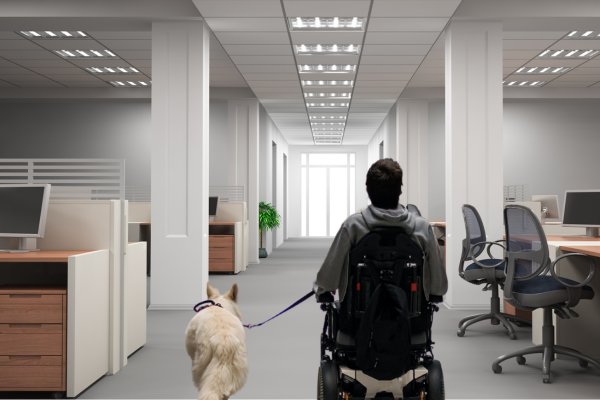At Justice Speaks we get a lot of questions about the rules and regulations for service dogs being in the workplace. Service dogs are used for many different reasons and are an essential to some people who have disabilities. There are many requirements of employers and employees when a service dog is entering a workplace and concerns may arise. The main thing to remember if you are concerned about a service dog in the workplace is that they are not there for entertainment or to distract employees. They have their own job to do and are taking care of the needs of their handler. In a lot of cases, having a service dog will improve the workplace environment rather than interfering with daily operations.
What are the rights for having service dogs at your workplace?
Title I of the Americans Disability Act covers employment and considers service animals a reasonable accommodation. This is defined by the ADA as “any change to the application or hiring process, to the job, to the way the job is done, or the work environment that allows a person with a disability who is qualified for the job to perform the essential functions of that job and enjoy equal employment opportunities.” Title I does not explicitly allow for service dogs to be brought into the workplace. The employee must request that their service dog is allowed in the workplace and the employer ultimately gets to make the decision. Employers should have a conversation with the employee to assess that the service dog is registered and sufficiently trained. Employers should ensure that the use of the service dog at work will improve the employees ability to do their job and will not be disruptive to the workplace environment.
What roles can service dogs play in the workplace?
Having a service dog in the workplace can be used for many different situations. Service dogs are commonly used for support for workers with mental and physical disabilities. This could include a guide dog for visual or hearing impaired employees, a medical response dog, Service dogs are there to provide support, and should improve employee performance in any of these cases.
How are Emotional Support Animals used in the workplace? How does this differ from service dogs?
Emotional Support Animals are not trained the same way service animals are, but the use of ESAs has proven itself time and time again. For example, big corporations like Apple and Google allow employees to bring their pets into the workplace. They have seen how ESAs can lower heart rate and stress levels which makes employees more productive and focused. Employers do not have to approve ESAs by law but they may still support it as we see more and more businesses implementing it into their workplace.
@theanxiousmess_ Fun fact! My gf and I both had service dogs and both work here! #JingleJangleWithMe #BakingSzn #animal #dog #puppy #servicedog #serviceanimal #tjmaxx ♬ Buttercup – Jack Stauber
This video shows an employee and her work day with her service dog. She shows us how she keeps her service dog out of the way of customers and other employees and how having her service dog improves her workday.
What are some common concerns regarding dogs in the workplace?
Employers and other employees may have concerns about having a service dog in the workplace. The first thing a handler should do is to have a discussion with employees regarding their comfort level with having a service dog present during the workday. Any problems that may arise can be addressed and talked through with employees before bringing the service dog into the workplace.
Allergies
Allergies are a common and very real concern, but there are multiple ways to avoid conflict between employees with allergies and service dog handlers. Separating the service animal and the employee with an allergy as far apart as possible to avoid allergic reactions is one of the best ways to deal with this concern. Typically the person with the allergy won’t be affected if they are over six feet away from the dog or in a separate room. Ensuring that the service dog is cleaned up after (including shedding) reduces the risk for the person with the allergy. This may also include washing the dog and their gear if they have to be in the same room or area as the person with the allergy. This article is a great example of how a service dog handler accommodates coworkers who are allergic to dogs: Allergies and Fears of Service Dogs.
Fears and Phobias
Fear is a factor when bringing a service dog into the workplace as other employees may not feel safe around dogs. Service dogs are typically thoroughly trained and do not pose a threat to people but phobias can be debilitating. In an article on PubMed Central: Dogs in the Workplace: A review of the Benefits and Potential Challenges, dog phobia is explained as a type of animal-specific phobia, defined as a marked fear or anxiety about the animal at levels that are out of proportion to the actual danger, active avoidance of the animal, and clinically significant distress or impairment in social, occupation, or other areas of functioning. Separating the employee who is fearful and the handler can help combat the fear. The handler should also make sure the dog is never loose or wandering the workplace. Clear communication between the handler and the employee will build a sense of mutual respect and understanding. This will hopefully allow for both of them to be accommodated and comfortable in their place of work.
Productivity
Productivity is often a concern for employers. It is important for them to remember that service dogs are not there to entertain people, they are doing a job as well. The handler should make sure other employees are aware of that before bringing their service dog into the workplace. The service dog should have a proper service dog vest and label that states they are working and should not be pet by anyone else. The employee with the service dog should have increased productivity because their dog is taking care of them, monitoring and alerting them if something is wrong. This will allow the employee to truly focus on the task at hand. The concern about productivity is often proven wrong once the employer sees that the dog is not causing disruptions to the handler or any other employees who work alongside the handler.
@moxiesadventures Baby steps! #servicedogintraining #servicedog #workingdogs #servicedogsoftiktok #disabilityawareness #disabilitytiktok #disabilityadvocate #positivereinforcementdogtraining #dogtraining #dogsoftiktok #puppiesoftiktok ♬ Selfcare-demo – Bella Moulden
This video shows how dogs can be trained to work in busy settings without getting distracted.
Creating a supportive workplace environment
Service dogs have a crucial job to accomplish for their handler during the workday. Introducing a service dog into the workplace may take some time and there may be accommodations required for both the handler and other employees. The ADA states that service animals are a reasonable accommodation for people with disabilities. If a service dog is registered and the rules surrounding petting or playing with a service dog are enforced there is no reason for them to not be allowed in the workplace. They are focused on doing their job and helping their handler be productive with their work day. With employer and employee communication, understanding, and respect, the needs and rights of service dog handlers can be met while creating a comfortable work environment for everyone.


